Family name: Amaryllidaceae J. St.-Hilaire
Synonym(s): Agapanthaceae F. Voigt; Alliaceae Borkh., nom. cons.; Brunsvigiaceae Horan.; Cepaceae Salisb.; Cyrtanthaceae Salisb.; Galanthaceae G. Mey.; Gethyllidaceae Raf.; Gilliesiaceae Lindl.; Haemanthaceae Salisb.; Leucojaceae Batsch ex Borkh.; Milulaceae Traub; Narcissaceae Juss.; Oporanthaceae Salisb.; Pancratiaceae Horan.; Strumariaceae Salisb.; Tulbaghiaceae Salisb.; Zephyranthaceae Salisb.
Common name(s): amaryllis family
*Number of genera/species: 75/1,600
List of genera records in GRIN-Global
fruit or seed
Fruit a loculicidalloculicidal:
type of capsular dehiscence, opening longitudinally through the locules (compare septicidal)
 capsulecapsule:
capsulecapsule:
a dry, dehiscent fruit derived from a compound ovary , sometimes a berryberry:
, sometimes a berryberry:
an indehiscent, fleshy fruit with one or a few to many seeds. The flesh may be homogenous throughout. Or, if the outer part is hard, firm, or leathery, referred to as an hesperidium. Septa are present in some, and the seeds may be arillate or with a fleshy testa.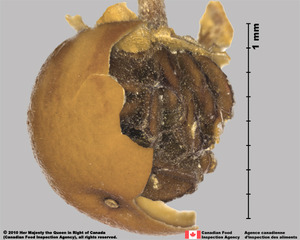 , 4–76 mm long, oblateoblate:
, 4–76 mm long, oblateoblate:
depressed globose
to fusiformfusiform:
spindle-shaped; broadest at the middle and tapering at both ends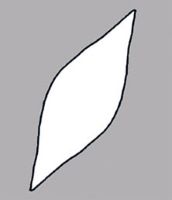 , tereteterete:
, tereteterete:
approximately circular in cross section; width and thickness approximately equal
 or angledangular:
or angledangular:
2D shape—having sides that meet at acute or obtuse angles
in transection, beakedbeak:
a usually firm, terminal appendage, sometimes tapered (Ammocharis, Boophone, Crinum spp.), with one, few, or many seeds. Perianth sometimes persistent. Pericarp white, green, purple, yellow, orange, or red, membranousmembranous:
(Ammocharis, Boophone, Crinum spp.), with one, few, or many seeds. Perianth sometimes persistent. Pericarp white, green, purple, yellow, orange, or red, membranousmembranous:
texture—extremely thin, pliable, and fairly tough
, leatheryleathery:
texture—moderately thick, tough, and very pliable
, fleshy or indurateindurate:
texture—hardened or stony; yielding under strong pressure; not deformable without internal structural disruption
, and often 3- or 6-lobed to ribbedribbed:
surface relief—wide, prominent, linear ridges that are generally rounded and longitudinally situated on the surface or undulateundulate:
or undulateundulate:
wavy-margined
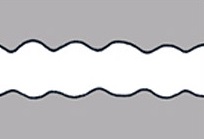 .
.
Seeds globose to ovateovate:
2D shape—egg-shaped in outline, widest point is towards one end of the organ, the other end tapers gradually, attachment at or near the broad end (compare obovate, ovoid)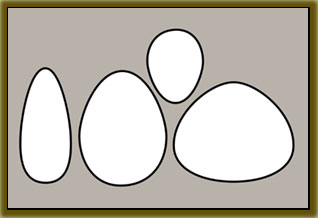 , D-shapedD-shaped:
, D-shapedD-shaped:
2D shape—has one straight margin and one curved margin, resembling the shape of the letter D
, or cuneiformcuneiform:
wedge-shaped
, compressedcompressed:
flattened; in grasses, used to denote compression (not necessarily flattened) either laterally or dorsiventrally
, triangulartriangular:
2D shape—three relatively straight sides with distinct corners; more angular than teardrop-shaped , or tereteterete:
, or tereteterete:
approximately circular in cross section; width and thickness approximately equal
 in transection, 2–43 mm long. Flattened seeds are usually winged. Galanthus, Leucojum, Narcissus, Sternbergia, and Pancratium seeds have fleshy elaisomes. Seed coat loose, shinyshiny:
in transection, 2–43 mm long. Flattened seeds are usually winged. Galanthus, Leucojum, Narcissus, Sternbergia, and Pancratium seeds have fleshy elaisomes. Seed coat loose, shinyshiny:
uniformly reflecting a high proportion of incident light at all angles or dulldull:
or dulldull:
reflecting only a low proportion of incident light, with no apparent sheen , smooth or variously ornamented.
, smooth or variously ornamented.
Seeds are often orthodoxorthodox:
(of seed) seed that can be dried to low moisture levels
, usually with a phytomelanphytomelan:
carbonaceous, opaque material that usually covers the seed coat to give it a black appearance, common in certain monocot families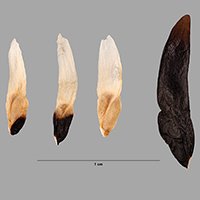 crust, and black or brown in color, but in a number of genera, the seeds are recalcitrantrecalcitrant:
crust, and black or brown in color, but in a number of genera, the seeds are recalcitrantrecalcitrant:
(of seed) seed cannot be dried below relatively high moisture levels
with high water content (or turgid) and without a phytomelanphytomelan:
carbonaceous, opaque material that usually covers the seed coat to give it a black appearance, common in certain monocot families crust. These turgid seeds are often large, globoseglobose:
crust. These turgid seeds are often large, globoseglobose:
3D shape—more or less spherical , and green. In Brunsvigia, Crossyne, Hessea, Nerine, and Strummaria seeds, the seed coats and embryos are green. In Amaryllis seeds, the seed coats are not green, but the embryos are green. Species of Crinum with turgid seeds also have green embryos.
, and green. In Brunsvigia, Crossyne, Hessea, Nerine, and Strummaria seeds, the seed coats and embryos are green. In Amaryllis seeds, the seed coats are not green, but the embryos are green. Species of Crinum with turgid seeds also have green embryos.
Embryo well developed, axil and centric, linearlinear:
(shape) long, narrow, and uniform in width; (of embryo) embryo is straight and much longer than wide , straight or curvedcurved:
, straight or curvedcurved:
(of embryo) linear embryo is curved into an arch or horseshoe with the ends far apart .
.
Endosperm copious, fleshy or hard.
Commonly intercepted at ports. Weedy in forests, shrubs, grasslands, and lawns. Spreads by bulb or bulbil propagation and seed reproduction often growing in dense mats or stands.
Aquarium & Pond Plants of the World tool includes descriptions and images of genera, which may be encountered.
| Fruit | |
| Type | loculicidalloculicidal: type of capsular dehiscence, opening longitudinally through the locules (compare septicidal)  capsulecapsule: capsulecapsule:a dry, dehiscent fruit derived from a compound ovary  , sometimes a berryberry: , sometimes a berryberry:an indehiscent, fleshy fruit with one or a few to many seeds. The flesh may be homogenous throughout. Or, if the outer part is hard, firm, or leathery, referred to as an hesperidium. Septa are present in some, and the seeds may be arillate or with a fleshy testa.  |
| Size range | 4–76 mm long |
| Shape(s) | oblateoblate: depressed globose , oblongoblong: 2D shape—much longer than broad with nearly parallel sides, corners are rounded  , ellipsoidellipsoid: , ellipsoidellipsoid:3D shape—elliptic , ovoidovoid: 3D shape—ovate  , cylindricalcylindrical: , cylindricalcylindrical:3D shape—a cylinder, with parallel sides and a circular cross-section; tubular or rod-shaped , obcordateobcordate: 2D shape—heart-shaped, with attachment at or near the narrow end (compare cordate) 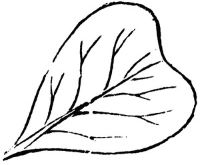 , cuneiformcuneiform: , cuneiformcuneiform:wedge-shaped , fusiformfusiform: spindle-shaped; broadest at the middle and tapering at both ends  , trigonoustrigonous: , trigonoustrigonous:3D shape—having three faces that meet at distinct angles; triangular in outline , teardrop-shapedteardrop-shaped: 2D shape—widest point is toward one end of the fruit, the other end tapers sharply to a pointed end 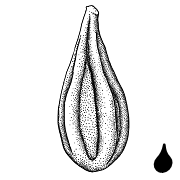 |
| Texture | fleshy, indurateindurate: texture—hardened or stony; yielding under strong pressure; not deformable without internal structural disruption , membranousmembranous: texture—extremely thin, pliable, and fairly tough , leatheryleathery: texture—moderately thick, tough, and very pliable |
| Surface relief | smooth or ribbedribbed: surface relief—wide, prominent, linear ridges that are generally rounded and longitudinally situated on the surface  , undulated , undulated |
| Color(s) | red, yellow, orange, purple, green, white, sometimes specked |
| Unique features | Often brightly colored capsulescapsule: a dry, dehiscent fruit derived from a compound ovary  , sometimes berriesberry: , sometimes berriesberry:an indehiscent, fleshy fruit with one or a few to many seeds. The flesh may be homogenous throughout. Or, if the outer part is hard, firm, or leathery, referred to as an hesperidium. Septa are present in some, and the seeds may be arillate or with a fleshy testa.  , with beaks formed from periogone tubes in several genera, and black or brown phytomelan-encrusted seeds. , with beaks formed from periogone tubes in several genera, and black or brown phytomelan-encrusted seeds. |
| Seed | |
| Size range | 2–43 mm long |
| Shape(s) | globoseglobose: 3D shape—more or less spherical  , ovoidovoid: , ovoidovoid:3D shape—ovate  , ellipsoidellipsoid: , ellipsoidellipsoid:3D shape—elliptic , D-shapedD-shaped: 2D shape—has one straight margin and one curved margin, resembling the shape of the letter D , cuneiformcuneiform: wedge-shaped |
| Surface relief | ribbedribbed: surface relief—wide, prominent, linear ridges that are generally rounded and longitudinally situated on the surface  , reticulatereticulate: , reticulatereticulate:surface relief—netted, raised walls or concave grooves forming a net-like surface pattern with flat, concave, or convex interspaces  , papillatepapillate: , papillatepapillate:surface relief—bearing minute, distinct, broad-based projections, tapering to a rounded apex  , wartywarty: , wartywarty:surface relief—distinct, rounded projections that are large relative to the fruit size; tuberculate, verrucose  , wrinkledwrinkled: , wrinkledwrinkled:surface relief—shallow, irregular folds and furrows covering the surface; appearing overall though crumpled and then spread out  , pittedpitted: , pittedpitted:surface relief—surface with small depressions in which the areas between the hollows do not take on the appearance of a true reticular net  |
| Color(s) | black, brown, green, red, white, gray |
| Unique features | Seeds usually phytomelan-encrusted, sometimes winged or with elaiosomeselaiosome: a lipid and protein-rich fleshy structure attached to some seeds and fruits, it attracts ants which then disperse the disseminule (e.g., caruncle in the Euphorbiaceae, the aril (outgrowth of the funiculus) in the Fabaceae) 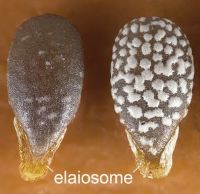 . . |
| Other | |
| Embryo | well developed, axil and centric, linearlinear: (shape) long, narrow, and uniform in width; (of embryo) embryo is straight and much longer than wide  , straight or curvedcurved: , straight or curvedcurved:(of embryo) linear embryo is curved into an arch or horseshoe with the ends far apart  |
| Nutritive tissue | endosperm copious, fleshy or hard in texture |
Temperate and tropical areas in the Americas, Eurasia, Africa, Australia and the Pacific Islands.
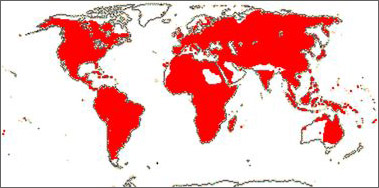
Distribution map courtesy of Angiosperm Phylogeny Website.
Baskin and Baskin 2021Baskin and Baskin 2021:
Baskin C and Baskin J. 2021. Relationship of the lateral embryo (in grasses) to other monocot embryos: A status up-grade. Seed Science Research 31 (3): 199-210. doi:10.1017/S0960258521000209; Bingham et al. 2021+Bingham et al. 2021+:
Bingham MG, Willeman A, Wursten BT, Ballings P, and Hyde MA. 2021. Flora of Zambia. Accessed January 2021–April 2024. URL: https://www.zambiaflora.com; Dahlgren et al. 1985Dahlgren et al. 1985:
Dahlgren RMT, Clifford HT, and Yeo PF. 1985. The families of the monocotyledons: structure, evolution, and taxonomy. Springer-Verlag, Berlin. 520 pp.; Nooteboom et al. 2021+Nooteboom et al. 2021+:
Nooteboom HP, de Wilde WJJO, Stevens PF, Coode MJE, and Saw LG. 2021+ Flora Malesiana Online. Accessed January 2021–March 2024. URL: https://portal.cybertaxonomy.org/flora-malesiana/; Flora of Australia 2021+Flora of Australia 2021+:
Flora of Australia. Australian Biological Resources Study, Canberra. Accessed January 2021–March 2024. URL: http://www.ausflora.org.au; Flora of North America Editorial Committee 1993+Flora of North America Editorial Committee 1993+:
Flora of North America Editorial Committee, eds. 1993+. Flora of North America North of Mexico [Online]. 22+ vols. Flora of North America Association, New York and Oxford. Accessed January-March 2024. URL: http://beta.floranorthamerica.org.; Hyde et al. 2021aHyde et al. 2021a:
Hyde MA, Wursten BT, Ballings P, and Coates Palgrave M. 2021a. Flora of Botswana. Accessed January–April 2024. URL: https://www.botswanaflora.com/index.php; Hyde et al. 2021b+Hyde et al. 2021b+:
Hyde MA, Wursten BT, Ballings P, and Coates Palgrave M. 2021b. Flora of Mozambique. Accessed January 2021–April 2024. URL: https://www.mozambiqueflora.com/index.php; Kativu 2002Kativu 2002:
Kativu S. 2002. Alliaceae of the Flora Zambesiaca area. Kirkia 18 (1): 72-76. https://www.jstor.org/stable/23502379; Kirkbride et al. 2006Kirkbride et al. 2006:
Kirkbride JH, Jr, Gunn CR, and Dallwitz MJ. 2006. Family guide for fruits and seeds, vers. 1.0. Accessed September 2020-January 2022. URL: https://nt.ars-grin.gov/seedsfruits/keys/frsdfam/index.cfm .; Kubitzki et al. 1990+Kubitzki et al. 1990+:
Kubitzki K et al., eds. 1990+. The families and genera of vascular plants. 7+ vols. Berlin etc.; Milliken et al. 2009+Milliken et al. 2009+:
Milliken W, Klitgard B, and Baracat A. 2009+. Neotropikey - Interactive key and information resources for flowering plants of the Neotropics.; Nordal 1982Nordal 1982:
Nordal I. 1982. Amaryllidaceae. In: Polhill RM, ed. Flora of Tropical East Africa. Vol 6. AA Balkema, Rotterdam Netherlands. 31 pp.; Snijman 1984Snijman 1984:
Snijman DA. 1984. A revision of the genus Haemanthus L. (Amaryllidaceae). The Journal of South African Botany. Supplementary 12.; Snijman 2005Snijman 2005:
Snijman DA. 2005. A new species of Namaquanula (Amaryllidaceae: Amaryllideae) from Namibia with notes on the genus. Bothalia 35 (2): 153-156. http://dx.doi.org/10.4102/abc.v35i1.390; Snijman 2013Snijman 2013:
Snijman DA. 2013. Plants of the Greater Cape Floristic Region, Vol 2: The Extra Cape flora. Strelitzia 30. South African National Biodiversity Institute, Pretoria.; Snijman and Linder 1996Snijman and Linder 1996:
Snijman DA and Linder HP. 1996. Phylogenetic relationships, seed characters, and dispersal system evolution in Amaryllideae (Amaryllidaceae). Annals of the Missouri Botanical Garden 83: 362-386.; Stevenson and Loconte 1995Stevenson and Loconte 1995:
Stevenson DW and Loconte H. 1995. A cladistic analysis of monocot families. In: Rudall PJ, Cribb PJ, Cutler DF, and Humphries CJ, eds. Monocotyledons: Systematics and Evolution. Royal Botanic Gardens, Kew.; Takhtajan 1997Takhtajan 1997:
Takhtajan A. 1997. Diversity and Classification of Flowering Plants. Columbia University Press, New York. 643 pp.; Thiselton-Dyer 1896–1897Thiselton-Dyer 1896–1897:
Thiselton-Dyer WT. 1896–1897. Flora capensis: being a systematic description of the plants of the Cape colony, Caffraria, & Port Natal (and neighbouring territories). Vol. 6. L. Reeve, Kent UK. 563 pp. https://doi.org/10.5962/bhl.title.821 ; Thulin 1995Thulin 1995:
Thulin M, eds. 1995. Flora of Somalia 4: 1-298. The Royal Botanical Gardens, Kew.; Tutin et al. 1964–1980Tutin et al. 1964–1980:
Tutin TG, Burges NA, Chater AO, Edmondson JR, Heywood VH, Moore DM, Valentine DH, Walters SM, and Webb DA (eds.) 1964–1980. Flora Europaea. 5 vols. Cambridge University Press, Cambridge UK. 2,524 pp.; van Bruggen 1969van Bruggen 1969:
van Bruggen HWE. 1969. Revision of the genus Aponogeton (Aponogetonaceae). Blumea 16 (1): 143-265.; Watson and Dallwitz 1992+Watson and Dallwitz 1992+:
Watson L and Dallwitz MJ. 1992+. The families of flowering plants: descriptions, illustrations, identification, and information retrieval. Version: 6th Accessed September 2020-September 2022. URL: delta-intkey.com; Zhengyi et al. 2004+Zhengyi et al. 2004+:
Zhengyi W, Raven PH, and Deyuan H. 2004+. Flora of China [online]. 25 vols. Science Press, Beijing China & Missouri Botanical Garden, St. Louis USA. Accessed January–March 2024. http://flora.huh.harvard.edu/china/; Zimudzi et al. 2006Zimudzi et al. 2006:
Zimudzi C, Archer RH, Kwembeya EG, and Nordal I. 2006. Synopsis of Amaryllidaceae from the Flora Zambesica Area. Kirkia 18 (2): 151-168. https://www.jstor.org/stable/23502325
*The number of genera and species is based on Christenhusz and Byng 2016Christenhusz and Byng 2016:
Christenhusz MJM and Byng JW. 2016. The number of known plant species in the world and its annual increase. Phytotaxa 261 (3): 201-217. https://doi.org/10.11646/phytotaxa.261.3.1, which may differ from the number of genera in GRIN-Global.